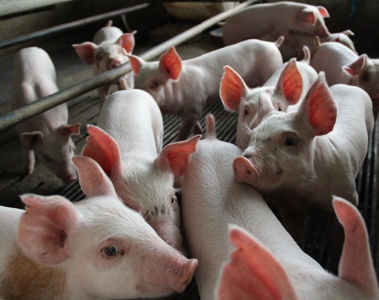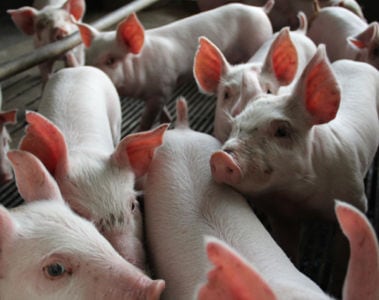Blavi L, Solà-Oriol D, Llonch P, López-Vergé S, Martín-Orúe SM, Pérez JF. Management and Feeding Strategies in Early Life to Increase Piglet Performance and Welfare around Weaning: A Review. Animals (Basel). 2021 Jan 25;11(2):302. doi: 10.3390/ani11020302. PMID: 33503942; PMCID: PMC7911825.
Cole, B. J. A., R. M. Beal, and J. R. Luscombe. 1968. The effect on performance and bacterial flora of lactic acid, propionic acid, calcium propionate and calcium acrylate in the drinking water of weaned pigs. Vet. Rec. 83:459
Lange, C. F. M. et al. Strategic use of feed ingredients and feed additives to stimulate gut health and development in young pigs. Livestock Science, v. 134, n. 1-3, p. 124-134, 2010.
Gaudré, D., & Quiniou, N. (2009). What mineral and vitamin levels to recommend in swine diets?. Revista Brasileira de Zootecnia, 38, 190-200.
Halas, D., Hansen, C.F., Hampson, D.J., Mullan, B.P., Wilson, R.H., Pluske, J.R., 2009. Effects of feeding an inulin-enriched weaner pig diet, either alone or with benzoic acid, on faecal consistency, post-weaning diarrhea, and gastrointestinal tract fermentation and growth performance. Archives of Anim. Nutr.
Menegat, Mariana B., Robert D. Goodband, Joel M. DeRouchey, Mike D. Tokach, Jason C. Woodworth, and Steve S. Dritz. 2019. Kansas State University Swine Nutrition Guide: Specialty Ingredients in Nursery Diets.
Menegat, Mariana B., Robert D. Goodband, Joel M. DeRouchey, Mike D. Tokach, Jason C. Woodworth, and Steve S. Dritz. 2019. Kansas State University Swine Nutrition Guide: Nursery Phase Feeding Program.
Menegat, Mariana B., Robert D. Goodband, Joel M. DeRouchey, Mike D. Tokach, Jason C. Woodworth, and Steve S. Dritz. 2019. Kansas State University Swine Nutrition Guide: Energy Sources for Swine Diets: Cereal Grains and Co-Products.
Menegat, Mariana B., Robert D. Goodband, Joel M. DeRouchey, Mike D. Tokach, Jason C. Woodworth, and Steve S. Dritz. 2019. Kansas State University Swine Nutrition Guide: Energy Sources for Swine Diets: Fats and Oils.
Moita, V.H.C.; Kim, S.W. Nutritional and Functional Roles of Phytase and Xylanase Enhancing the Intestinal Health and Growth of Nursery Pigs and Broiler Chickens. Animals 2022, 12, 3322. https:// doi.org/10.3390/ani12233322
Rosenfelder-Kuon, Wolfgang Siegert & Markus Rodehutscord (2020) Effect of microbial phytase supplementation on P digestibility in pigs: a meta-analysis, Archives of Animal Nutrition, 74:1, 1-18, DOI: 10.1080/1745039X.2019.1687249
Pluske J.R., Hampson D.J., Williams I.H. Factors influencing the structure and function of the small intestine in the weaned pig: A review. Livest. Prod. Sci. 1997;51:215–236. doi: 10.1016/S0301-6226(97)00057-2.
Pluske J.R., Kim J.-C., Hansen C.F., Mullan B.P., Payne H.G., Hampson D.J., Callesen J., Wilson R.H. Piglet growth before and after weaning in relation to a qualitative estimate of solid (creep) feed intake during lactation: A pilot study. Arch. Anim. Nutr. 2007;61:469–480. doi: 10.1080/17450390701664249.
Rudar M, Fiorotto ML, Davis TA. Regulation of Muscle Growth in Early Postnatal Life in a Swine Model. Annu Rev Anim Biosci. 2019 Feb 15;7:309-335. doi: 10.1146/annurev-animal-020518-115130. Epub 2018 Nov 2. PMID: 30388025; PMCID: PMC7032524.
Sampath V, Sureshkumar S, Seok WJ, Kim IH. Role and functions of micro and macro-minerals in swine nutrition: a short review. J Anim Sci Technol. 2023 May;65(3):479-489. doi: 10.5187/jast.2023.e9. Epub 2023 May 31. PMID: 37332284; PMCID: PMC10271933.
Thomlinson, J. R., and T. L. J. Lawrence. 1981. Dietary manipulation of gastric pH in the prophylaxis of enteric disease in weaned pigs: some field observations. Vet. Rec. 109:120.
White, F., G. Wenham, G. A. M. Sharman, A. S. Jones, E. A. S. Rattray, and I. McDonald. 1969. Stomach function in relation to stomach scouring in the pig. Brit. J. Nutr. 23:847-857.
Woyengo, T. A., Beltranena, E., & Zijlstra, R. T. (2017). Effect of anti-nutritional factors of oilseed co-products on feed intake of pigs and poultry. Animal Feed Science and Technology, 233, 76-86.



